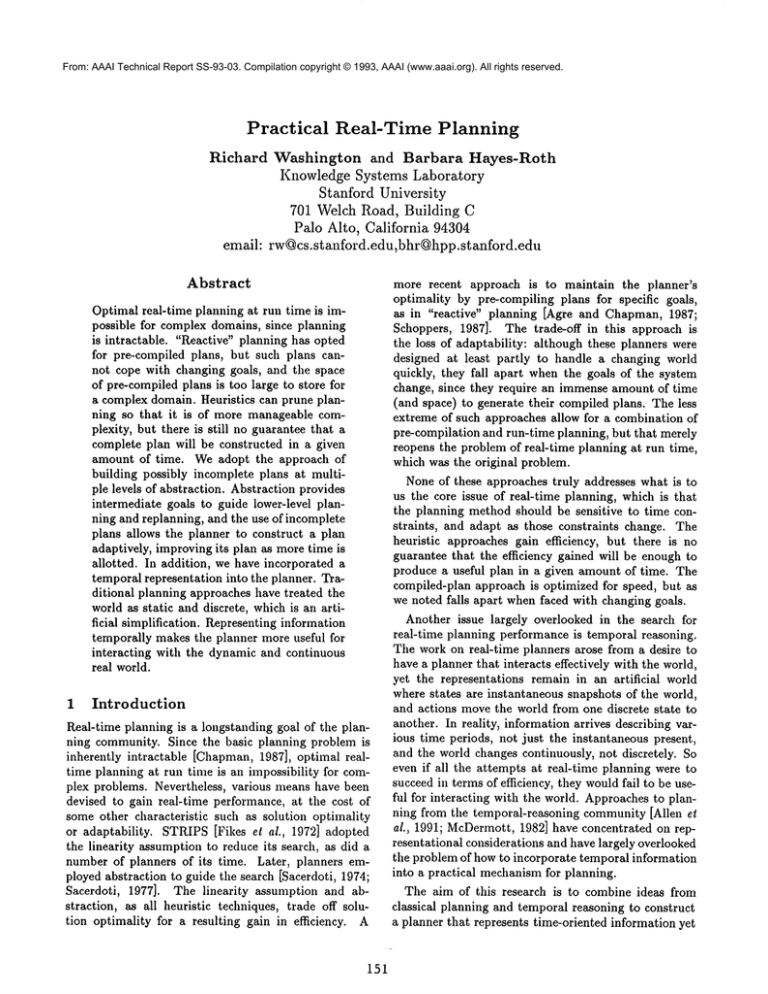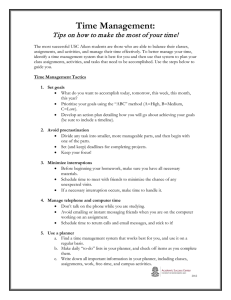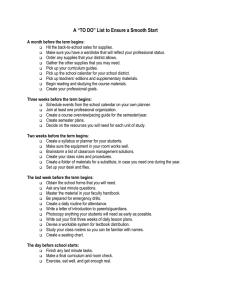
From: AAAI Technical Report SS-93-03. Compilation copyright © 1993, AAAI (www.aaai.org). All rights reserved.
Practical
Real-Time
Planning
Richard
Washington
and Barbara
Hayes-Roth
Knowledge Systems Laboratory
Stanford University
701 Welch Road, Building
C
Palo Alto, California
94304
emaih rw@cs.stanford.edu,bhr@hpp.stanford.edu
Abstract
Optimal real-time planning at run time is impossible for complex domains, since planning
is intractable. "Reactive" planning has opted
for pre-colnpiled plans, but such plans cannot cope with changing goals, and the space
of pre-compiled plans is too large to store for
a complex domain. Heuristics can prune planning so that it is of more manageable complexity, but there is still no guarantee that a
complete plan will be constructed in a given
amount of time. We adopt the approach of
building possibly incomplete plans at multiple levels of abstraction. Abstraction provides
intermediate goals to guide lower-level planning and replanning, and the use of incomplete
plans allows the planner to construct a plan
adaptively, improving its plan as more time is
allotted. In addition, we have incorporated a
temporal representation into the planner. Traditional planning approaches have treated the
world as static and discrete, which is an artificial simplification. Representing information
temporally makes the planner more useful for
interacting with the dynamic and continuous
real world.
1
Introduction
Real-time planning is a longstanding goal of the planning community. Since the basic planning problem is
inherently intractable [Chapman, 1987], optimal realtime planning at run time is an impossibility for complex problems. Nevertheless, various means have been
devised to gain real-time performance, at the cost of
some other characteristic such as solution optimality
or adaptability.
STRIPS[Fikes et al., 1972] adopted
the linearity assumption to reduce its search, as did a
number of planners of its time. Later, planners employed abstraction to guide the search [Sacerdoti, 1974;
Sacerdoti, 1977]. The linearity assumption and abstraction, as all heuristic techniques, trade off solution optimality for a resulting gain in efficiency. A
151
more recent approach is to maintain the planner’s
optimality by pre-compiling plans for specific goals,
as in "reactive" planning [Agre and Chapman, 1987;
Schoppers, 1987]. The trade-off in this approach is
the loss of adaptability: although these planners were
designed at least partly to handle a changing world
quickly, they fall apart when the goals of the system
change, since they require an immense amount of time
(and space) to generate their compiled plans. The less
extreme of such approaches allow for a combination of
pre-compilation and run-time planning, but that merely
reopens the problem of real-time planning at run time,
which was the original problem.
None of these approaches truly addresses what is to
us the core issue of real-time planning, which is that
the planning method should be sensitive to time constraints, and adapt as those constraints change. The
heuristic approaches gain efficiency, but there is no
guarantee that the efficiency gained will be enough to
produce a useful plan in a given amount of time. The
compiled-plan approach is optimized for speed, but as
we noted falls apart when faced with changing goals.
Another issue largely overlooked in the search for
real-time planning performance is temporal reasoning.
The work on real-time planners arose from a desire to
have a planner that interacts effectively with the world,
yet the representations remain in an artificial
world
where states are instantaneous snapshots of the world,
and actions movethe world from one discrete state to
another. In reality, information arrives describing various time periods, not just the instantaneous present,
and the world changes continuously, not discretely. So
even if all the attempts at real-time planning were to
succeed in terms of efficiency, they wouldfail to be useful for interacting with the world. Approachesto planning from the temporal-reasoning community [Allen et
al., 1991; McDermott, 1982] have concentrated on representational considerations and have largely overlooked
the problem of how to incorporate temporal information
into a practical mechanismfor planning.
The aim of this research is to combine ideas from
classical planning and temporal reasoning to construct
a planner that represents time-oriented information yet
remains sensitive to dynamic time constraints.
The
planner we have designed is a state-space planner (as in
STRIPS)that uses interval-based information. It plans
forward at multiple levels of abstraction, constructing
partial plans at each level. In this paper we discuss
the elements of the planning method and their operations, and justify our design choices in light of the overall goal of a practical real-time planner. In Section 2 we
present an exampleto illustrate someof the capabilities
we believe a planner should incorporate. In section 3
we show how the planner represents world information,
operators, and simple plans. In section 4 we introduce
abstraction into the planner as a technique to focus the
search and maintain globally consistent behavior. In
section 5 we discuss issues arising from this work along
with plans for future work.
2
An
Example
Suppose that we are in Berkeley and have a number
of Stanford souvenirs to deliver to Berkeley, Oakland,
and San Francisco. Berkeley and Oakland are adjacent, but San Francisco is reachable only via the Bay
Bridge. Wehave the goal of delivering all the souvenirs
by 5:00. In addition, we have a goal of being in Berkeley
from 12:00-1:00 so we can stop for lunch at a restaurant there. Starting out at 9:00, we hear that there was
an accident on the Bay Bridge at 8:00. Wecan deduce
that traffic has been slow from 8:00 and will continue
to be until 10:30. Given that information, we plan to
deliver souvenirs in Oakland first, then Berkeley, then
San Francisco. If everything goes as planned, we expect to be in Oakland 9:15-11:00, Berkeley 11:00-2:00
(satisfying the goal of being there for lunch), and San
Francisco 2:15-4:00, returning to Berkeley before 5:00.
Anadditional goal is to read an article about Stanford’s
success in the Big Game, which should require about a
half hour.
This general outline then provides goals for our more
specific actions. Weplan to leave Oakland at 11:00,
so that becomes a goal for our more specific driving
actions. Wecan map out a route that will take us to all
the delivery points while leaving us enough time to stop
at a donut shop to eat and read the article before we
have to drive to Berkeley. Nowwe start driving, only to
push a red light a bit too muchand get pulled over by
the police. This may delay us enough that we have to
skip the donut stop, but we can still meet our higherlevel schedule. In addition, the stop for the ticket can
be used to read the article, so we don’t have to fit that
in elsewhere in the schedule.
This example of an everyday planning task illustrates
the types of information and reasoning not offered by
existing real-time planning systems, but required to
construct practical real-time plans. This planning task
relies on the ability to acquire knowledge, make hypotheses, and establish goals for intervals of time. These
intervals range over times in the past, present, mid fu-
152
ture. The example also makes use of a high-level plan
to construct an initial plan and to modify that plan as
unexpected events occur.
3
3.1
Representation
World representation
In a discrete planner, the world is represented as a set
of assertions that describe what is true at that instant
in time. In a temporal planner, this expands to include
information over intervals of time. In our system, we
use a timeline that represents occurrences, expectations,
and intentions uniformly as values over time intervals.
An occurrence is an observation of the world or a
recording of some fact derived within the system. This
information is the system’s most reliable characterization of the state of the world in the present and past. An
expectation is a hypothesis about what is, was, or will
be true, based on some derivation that is not knownto
be sound. The system treats these as secondary sources
of information if no occurrence exists over a particular interval. In our example, the accident on the Bay
Bridge is an occurrence, giving rise to an expectation of
slow traffic. The goals of the planner are represented as
intentions on the timeline; for example, the goal of being in Berkeley at lunchtime stretches from 12:00-1:00.
The process of planning within this framework is to
generate actions, consistent with the current set of occurrences and expectations, whose expected effects will
satisfy the intentions. Furthermore, the planner should
monitor new occurrences to ensure that they meet the
expectations, and monitor the expectations to ensure
that they are consistent with the intentions, adjusting
the plan as necessary to resolve any discrepancies. A
conflict between occurrences and expectations indicates
either that the plan’s actions have had unexpected effects or that the world has changed in an unanticipated
way. In either case the plan may need to be modified
to incorporate the new information. A conflict between
expectations and intentions indicates that the plan is
not expected to satisfy the goals, so the plan may need
to be altered to achieve the violated goals.
The system has a complete timeline of occurrences,
expectations, and intentions at all times. So where discrete planners may hold a "state of the world," the
equivalent in this system is really the system’s state
of knowledgeabout the past, present, and future of the
world. This means that an operator is suitable to execute when the system knows certain information about
the world, but the operator’s execution time and the
time of the triggering information maybe different. For
example, the prediction that traffic will be slow on the
bridge early in the afternoon because it is a Friday may
prompt us to cross the bridge early in the day.
3.2 Operators ~ Plans
Operators in tile planner are essentially STRIPS-style
operators with temporal information added to the preconditions and effects. The process of deciding what
operators are appropriate at any point in time is more
complicated than a simple STRIPS-style check of a list
of predicates against the current world state. In a temporal planner, the triggering process must not only return whether an operator may execute, but when. To
return information about when an operator may execute, the triggering process must in effect perform an
intersection of the times allowed by each of the preconditions. So we can think of the triggering process
as iterating through the list of preconditions, matching
each against the timeline, and returning the set of operator execution times consistent with the information
on the timeline and that precondition.
In actuality, this triggering process is muchmore efficient. Whenan interval is added to the timeline, the
planner finds the set of operators that have a condition
satisfied by the added interval--this is done by merely
traversing a link in the knowledgebase. Then the operator’s conditions are checked against the timeline, using
the triggering interval to constrain the time extent of
each condition.
Whenan operator is chosen for execution, its effects
are added to the timeline as expectations. From the
planner’s point of view, the world is a black box. The
planner may have an approximate model of how the
world works, but it must rely on sensors to update its
knowledgeof the world state. So by executing an operator, the planner expects certain effects, but it must wait
for sensor information to confirm that the effects indeed
occurred. The planner may continue to plan based on
its expectations, under the assumption that the actions
will succeed. This is different from an approach like
[Schoppers, 1987], where the world is considered to be
so unpredictable that the planner is prevented from reasoning based on its past actions.
At a single level of abstraction, a plan in our system
is a set of operators arranged over time. Each operator has associated with it a time interval over which its
actions will execute. Unlike the traditional representation of a plan as a strict sequence of operators, in our
approach actions from different operators may overlap
in time. Sequences will emerge only when necessary,
for instance when one operator executes and changes
the world (or more accurately, the system’s knowledge
about the world) in a way that allows another operator
to execute.
Furthermore, a plan is constructed by selecti,lg operators that apply forward from the current set of occurrences and expectations on the timeline rather than
backward from the intentions. This is counter to the
custom in planning systems to search backwards (although some recent work on real-time planning has
also adopted a forward-searching approach [Drummond,
\
v
Operator O1
Preconditions:
Actions:
Effects:
Operator O~
Preconditions:
Actions:
Operator Oa
Preconditions:
Actions:
P1 over It - 10, t]
A1 over [t,t + 10]
P2 over It + 5, t + 15]
P1 over It - 15, t - 5]
A2over It, t + 5]
P2 over It, t + 10]
A3 over [t,t q- 10]
Figure 1: Operators’ actions may overlap. In this example, operator O1 and O2 both depend on P1, and 03
depends on the effects of O1’s action A1. All three could
potentially execute.
153
1989; Godefroid and Kabanza, 1991]). With time constraints,
the planner may not be able to construct a
complete plan. An incomplete forward plan is executable, unlike an incomplete backward plan, and as
more time is allotted to the planner, the plan more
closely approximates the optimal plan, roughly exhibiting "anytime" behavior [Dean and Boddy, 1988].
Figure 1 shows a simple example of a plan. Given
an initial interval of P1 true over the interval [0, 10],
the planner will notice that operators O1 and O2 can
execute. Based on the expected effects of O1, the planner will notice that operator O3 can execute based on
those effects. Its execution would also overlap that of
the other two operators, so that they all could execute
concurrently.
Planning explores a space of hypothetical states in
search of one that achieves the desired goal. The result
of an operator is a set of expectations about the outcome of the operator’s actions. If these outcomes are
indeed realized, other operators may be appropriate to
execute. But since a planner is merely proposing possible operators, their outcomes are only expected if the
operator is indeed executed. So the state containing a
planned operator’s effects is a hypothetical state, dependent on choosing that operator for execution. Whenthe
planner commits to a particular set of operators, their
effects are expected in the current (non-hypotheticM)
timeline. A hypothetical state for a planned operator
is the exact analogue of a branch point in a traditional
state-based plan where more than one operator can be
executed, and the choice of an operator leads the plan
down one of the branches. In our approach, the choice
is not mutually exclusive, since a plan is not merely
a strict sequence of operators, but rather a collection
of operators with dependencies on the results of other
operators. So the planning problem has changed from
finding a sequential ordering of operators to finding dependencies of operators on other operators’ effects.
As a plan is executed, the planner monitors the results of the plan to ensure that the world changes to
match the expectations within the plan. If information
arrives contradicting expectations, the parts of the plan
dependent on that expectation may be invalidated and
may need to be replaced. The procedure for replanning
is exactly the same as for planning. The operators consistent with the current state of the world as well as the
hypothetical states are proposed and expanded to form
a new plan. Since we consider planning to be an ongoing process, the plan is a continually evolving structure,
whether from internal changes to the plan or external
changes to the world.
4
current
state
----~--
~
current
state
hypothetical
states
J hypothetical~_.~
[
hypothetical[~
stateI - I
~te I
"
~J,
goals
Figure 2: Information exchanged among levels of abstraction.
Level 3
Level 2
Abstraction
One of the arguments traditionally leveled at a statebased planning system, especially a forward-searching
one, is that it is crippled by the combinatorial explosion of the search space. However,if intermediate goals
are established to reduce the search space, the combinatorial explosion is defused. Abstraction can provide
just such goals by having higher level plans supply intermediate goals to the lower-level plans.
Abstraction not only improves the efficiency of the
system, it also provides global information to guide the
initial planning and any required replanning. By following the outline of an abstract plan when building a
more specific plan, the system will ensure that the specific plan remains in accordance with its global, longterm goals. Since replanning is the same as planning
in our approach, when the world changes unexpectedly,
the abstract outline again allows the planner to rebuild
the plan to fit the new information.
Figure 2 shows how information flows among the
levels of abstraction. Occurrences or expectations are
propagated to higher levels of abstraction. This way
the state of the planner’s beliefs is consistent at all
levels of abstraction. Expectations that are the results of abstract planning are propagated to lower levels
of abstraction, giving rise to intentions (goals) at the
lower levels. This downwardtransformation of expectations into goals ([Washington and Hayes-Roth, 1990;
Knoblock, 1991]) is the way that the abstract search affects the lower-level search, by adding constraints that
narrow the lower-level search space.
The effect of this information flow amongthe levels
is to propagate information to where it is the most use154
LevelI
Figure 3: At any time, a plan may be either expanded
at one level of abstraction, or propagated to a lower
level of abstraction.
ful. Wheninformation arrives that invalidates part of
a plan, that information is propagated upward through
the levels of abstraction until the new information has
no effect on the state of the world at a particular level
of abstraction (for example, the traffic ticket in the
souvenir-delivery example affects the specific plan, but
not the higher-level schedule). Then the plan above
that level remains in effect, and will provide goals to
guide replanning at the lower levels of abstraction.
Given real-time constraints, there may not be enough
time to construct a complete plan at one or all levels
of abstraction. Wedo not require a complete plan at
any level of abstraction. Instead, the plan may at any
point be expanded further within one level of abstraction, or the information from that level may be propagated downwardto affect the plan at a lower level of
abstraction (see Figure 3). As a higher level plan
expanded or altered, the information may change the
goals at a lower level so that the plan at that lower
level mayno longer be the best with respect to the new
goals. In general, as long as the plan at a level is incomplete, there is the possibility that the plan is not
the optimal one for that level, and thus the lower level
plans are also suboptimal, since they are following the
higher-level information. This potential suboptimality
is the result of the limited time available for planning,
so as more time is allotted for planning, the resulting
plan will more closely approximate the optimal plan at
all levels of abstraction.
The intermediate goals propagated from abstract
plans also help when deadlines are reached before the
plan is expanded to an executable level. At each level
there is always a set of operators applicable to the current state. The short-term goals inherited from abstract
plans help the planner choose the best of the applicable operators. Without these goals, the choice is guided
only by goals too distant in the future to be of much
use. Under an impending deadline, the planner can determine an executable step by finding the best first step
at each level where no plan exists. As the planner finds
this first action at successively morespecific levels of abstraction, the action’s effects produce expected effects
that propagate to goals at lower levels, finally producing a short-term goal at the executable level that could
be used to choose a first step. In general the planner attempts to have an executable operator available before
the deadline, but if time ran out unexpectedly it could
resort to this procedure.
5
Conclusion
The planning method described in this paper is an attempt to extract the elements of temporal reasoning
and abstraction that can offer assistance to real-time
planning. The internal temporal representation of the
planner allows a more realistic characterization of the
world than a traditional static, instantaneous state description. The planner can thus build plans that are
more flexible than strict sequences of operators and
states. Abstraction allows the planner to narrow its
search space while remaining consistent with its global,
long-term goals. The abstract plan provides a framework that sketches a (partial) solution, which is then
used to set goals for lower level planning and replanning.
Wehave partially implemented the ideas presented
in this paper, and are in the process of completing the
implementation. Weare developing the planner in the
BB1architecture [Hayes-Roth, 1985], and will evaluate
it in the Guardian system for intensive-care monitoring [Hayes-Roth et al., 1989] as well as a simpler, more
quantifiable domainsimilar to the exampledelivery set’vice. Tile ideas and the implementation are intended to
be general, however, and apply to a wide array of realtime planning problems.
References
[Agre and Chapman, 1987] Agre, P. E. and Chapman,
D. 1987. Pengi: An implementation of a theory of
155
activity.
In Proceedings of AAAI-8Z AAAI.268-272.
[Allen et al., 1991] Allen, J. F.; Kautz, H. A.; Pelavin,
R. N.; and Tenenberg, J. D. 1991. Reasoning about
Plans. Morgan Kaufmann Publishers, Inc.
[Chapman, 1987] Chapman, D. 1987. Planning for conjunctive goals. Artificial Intelligence 32(3):333-377.
[Dean and Boddy, 1988] Dean, T. and Boddy, M. 1988.
An analysis of time-dependent planning. In Proceedings of AAAI-88. AAAI.
[Drummond, 1989] Drummond, M. E. 1989. Situated
control rules. In Proceedingsof the first international
conference on Principles of Knowledge Representation and Reasoning. 103-113.
[Fikes et al., 1972] Fikes, R.; Hart, P.; and Nilsson,
N. 1972. Learning and executing generalized robot
plans. Artificial Intelligence 3(4):251-288.
[Godefroid and Kabanza, 1991] Godefroid, P. and Kabanza, F. 1991. An efficient reactive planner for synthesizing reactive plans. In Proceedings of AAAI-91.
AAAI. 640-645.
[Hayes-Roth, 1985] Hayes-Roth, B. 1985. A blackboard architecture for control. Artificial Intelligence
26:251-321.
[Knoblock, 1991] Knoblock, C. A. 1991. Automatically
Generating Abstractions for Problem Solving. Ph.D.
Dissertation, Carnegie Mellon University.
[Hayes-Roth et al., 1989] Hayes-Roth, B.; Washington,
R.; Hewett, R.; Hewett, M.; and Seiver, A. 1989.
Intelligent monitoring and control. In Proceedings of
IJCAI-89. IJCAI. 243-249.
[McDermott, 1982] McDermott, D. 1982. A temporal
logic for reasoning about processes and plans. Cognitive Science 6:101-155.
[Sacerdoti, 1974] Sacerdoti, E. D. 1974. Planning in a
hierarchy of abstraction spaces. Artificial Intelligence
5(2):115-135.
[Sacerdoti, 1977] Sacerdoti, E. D. 1977. A Structure for
Plans and Behavior. Elsevier.
[Schoppers, 1987] Schoppers, M. J. 1987. Universal
plans for reactive robots in unpredictable environments. In Proceedings of IJCAI-87. IJCAI. 10391046.
[Washington and Hayes-Roth, 1990] Washington, R.
and Hayes-Roth, B. 1990. Abstraction planning in
real time. Technical Report KSL-90-15, Knowledge
Systems Laboratory, Stanford University.



